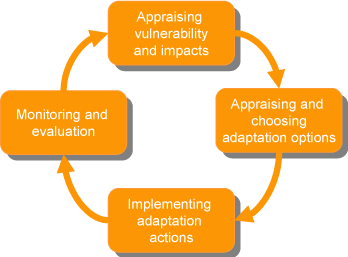Adaptation Task Navigator
The adaptation learning cycle
On a general level, there is wide agreement in the literature that adaptation should be approached as an iterative learning cycle consisting of the following four broad task:
- Appraising climate change vulnerability and impacts. The goal at this stage is to gain more knowledge about the risks and opportunities faced in the adaptation situation. Which impacts may be expected under climate change? Are the vulnerable actors aware of the threat? What are the major decisions that need to be addressed. What adaptation options are available?
- Appraising and choosing adaptation options. The goal of this stage is to decide between alternative adaptation options.
- Planning and implementing adaptation actions. The goal of this stage is to implement the options and thus to change the adaptation situation.
- Monitoring and evaluating adaptation options. The goal at this stage is to monitor the implementation process and the outcomes achieved, to evaluate what was done and to learn from the experiences gained.
These four broad tasks are usually iterated (Figure 1-1) because the last stage, the evaluation, leads to a new AS, which in turn needs to be further characterised.
While the names given to the cycle and the stages involved differ, iterative problem solving and learning is at the core of most conceptualizations of "real-world" problem solving processes such as the ones found in action research, trans-disciplinary research or so-called problem-oriented research as well as policy cycles. For a discussion of other prominent conceptualisations of this iterative learning cycle consult the Annex.
The duration of one iteration of this problem solving process differs for different adaptation situations and may last from several months to years or even decades. This document thus provides multiple entry points at which the analyst may start adaptation assessment and action. An analyst who is, for example, confronted with a challenge of developing a cross-sectoral adaptation plan would enter adaptation at the stage of "assessing vulnerability and impacts", while an analyst that is confronted with a particular decision would enter at the stage "Appraising and choosing adaptation options".

Figure 1-1: The adaptation learning cycle
